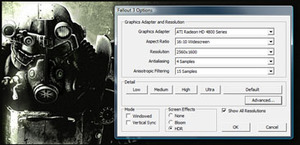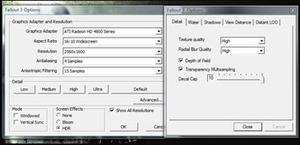Gainward Single PCB GTX 295 Review
Written by Harry Butler
August 10, 2009 | 12:07
Tags: #295 #cooled #geforce #gtx-295 #pcb #performance #results #review #single-pcb #tested

Fallout 3
Publisher: BethesdaFallout 3 is the revival of Interplay’s excellent Fallout series of games following many years out of the limelight. It’s developed and published by Bethesda and, judging by the success of the game, we’ll be seeing more Fallout games in the future.
Despite using the Oblivion engine which is now a few years old, the game looks absolutely stunning. Bethesda has spiced up the graphics a bit since Oblivion and has extended the engine – there are some great explosions, soft shadows and smoke effects that are particularly noteworthy.
We tested the game by manually playing a section of the game that incorporates a number of explosions and effects that you’re likely to experience during your time in post-apocalyptic Washington DC. We recorded the frame rate using FRAPS.
The in-game details were set to their highest values and both anti-aliasing and anisotropic filtering were controlled by the application settings instead of through the driver control panel. This meant that transparency anti-aliasing was enabled, along with HDR and all of the cool smoke effects.
Fallout 3’s engine is by default capped to 60 frames per second, which can make benchmark results very unclear, especially when testing at lower resolutions or with high end graphics cards. To remove the 60FPS cap you’ll need to find the Fallout3.ini file in \Documents\My Games\Fallout3 and edit the file so that iPresentInterval=0. This removes the frame rate cap, and allows us to get a much better idea of a card’s abilities.
Fallout 3
1,680 x 1,050 4xAA 16xAF, Maximum Detail
- Nvidia GeForce GTX 295 1,792MB
- Gainward Nvidia GeForce GTX 295 1,792MB
- ATI Radeon HD 4870 X2 2GB
- Sapphire Radeon HD 4890 1GB Atomic
- ATI Radeon HD 4890 1GB
- Nvidia GeForce GTX 285 1GB
- Nvidia GeForce GTX 275 896MB
-
-
84.0
-
49.0
-
-
-
83.7
-
49.0
-
-
-
83.7
-
56.0
-
-
-
82.4
-
44.0
-
-
-
79.2
-
38.0
-
-
-
78.2
-
45.0
-
-
-
73.6
-
40.0
-
0
10
20
30
40
50
60
70
80
90
Frames Per Second
-
Average
-
Minimum
Fallout 3
1,680 x 1,050 8xAA 16xAF, Maximum Detail
- ATI Radeon HD 4870 X2 2GB
- Gainward Nvidia GeForce GTX 295 1,792MB
- Nvidia GeForce GTX 295 1,792MB
- Sapphire Radeon HD 4890 1GB Atomic
- ATI Radeon HD 4890 1GB
- Nvidia GeForce GTX 285 1GB
- Nvidia GeForce GTX 275 896MB
-
-
83.0
-
47.0
-
-
-
82.3
-
50.0
-
-
-
82.1
-
49.0
-
-
-
80.4
-
33.0
-
-
-
76.3
-
32.0
-
-
-
69.8
-
33.0
-
-
-
64.1
-
30.0
-
0
10
20
30
40
50
60
70
80
90
Frames Per Second
-
Average
-
Minimum
Fallout 3
1,920 x 1,200 4xAA 16xAF, Maximum Detail
- ATI Radeon HD 4870 X2 2GB
- Nvidia GeForce GTX 295 1,792MB
- Gainward Nvidia GeForce GTX 295 1,792MB
- Sapphire Radeon HD 4890 1GB Atomic
- ATI Radeon HD 4890 1GB
- Nvidia GeForce GTX 285 1GB
- Nvidia GeForce GTX 275 896MB
-
-
83.6
-
47.0
-
-
-
82.6
-
51.0
-
-
-
82.5
-
51.0
-
-
-
79.5
-
38.0
-
-
-
74.9
-
31.0
-
-
-
74.7
-
39.0
-
-
-
67.1
-
32.0
-
0
10
20
30
40
50
60
70
80
90
Frames Per Second
-
Average
-
Minimum
Fallout 3
1,920 x 1,200 8xAA 16xAF, Maximum Detail
- ATI Radeon HD 4870 X2 2GB
- Gainward Nvidia GeForce GTX 295 1,792MB
- Nvidia GeForce GTX 295 1,792MB
- Sapphire Radeon HD 4890 1GB Atomic
- ATI Radeon HD 4890 1GB
- Nvidia GeForce GTX 285 1GB
- Nvidia GeForce GTX 275 896MB
-
-
82.8
-
45.0
-
-
-
82.5
-
51.0
-
-
-
82.2
-
50.0
-
-
-
77.4
-
29.0
-
-
-
70.9
-
29.0
-
-
-
62.1
-
29.0
-
-
-
58.1
-
25.0
-
0
10
20
30
40
50
60
70
80
90
Frames Per Second
-
Average
-
Minimum
Fallout 3
2,560 x 1,600 0xAA 16xAF, Maximum Detail
- Nvidia GeForce GTX 295 1,792MB
- Gainward Nvidia GeForce GTX 295 1,792MB
- ATI Radeon HD 4870 X2 2GB
- Sapphire Radeon HD 4890 1GB Atomic
- Nvidia GeForce GTX 285 1GB
- Nvidia GeForce GTX 275 896MB
- ATI Radeon HD 4890 1GB
-
-
84.0
-
48.0
-
-
-
83.8
-
48.0
-
-
-
83.6
-
48.0
-
-
-
75.6
-
40.0
-
-
-
74.9
-
35.0
-
-
-
71.3
-
33.0
-
-
-
69.2
-
34.0
-
0
10
20
30
40
50
60
70
80
90
Frames Per Second
-
Average
-
Minimum
Fallout 3
2,560 x 1,600 4xAA 16xAF, Maximum Detail
- Gainward Nvidia GeForce GTX 295 1,792MB
- Nvidia GeForce GTX 295 1,792MB
- ATI Radeon HD 4870 X2 2GB
- Sapphire Radeon HD 4890 1GB Atomic
- Nvidia GeForce GTX 285 1GB
- ATI Radeon HD 4890 1GB
- Nvidia GeForce GTX 275 896MB
-
-
82.2
-
50.0
-
-
-
82.0
-
49.0
-
-
-
81.1
-
30.0
-
-
-
63.6
-
25.0
-
-
-
61.6
-
27.0
-
-
-
58.5
-
21.0
-
-
-
56.0
-
23.0
-
0
10
20
30
40
50
60
70
80
90
Frames Per Second
-
Average
-
Minimum
Fallout 3 isn't the most demanding title with which to test these ultra-high end cards, and it shows with the both revisions of the GTX 295 and the HD 4870 X2 performing incredibly similarly due to the performance bottleneck occurring elsewhere in our overclocked Core i7 based system. However, the Nvidia card delivers significantly higher minimum frame rates than the competing Radeon at all but 1,680 x 1,050 with 4xAA making it the faster choice overall. Once again though, there's little to no performance difference between the original and revised GTX 295s.











Want to comment? Please log in.